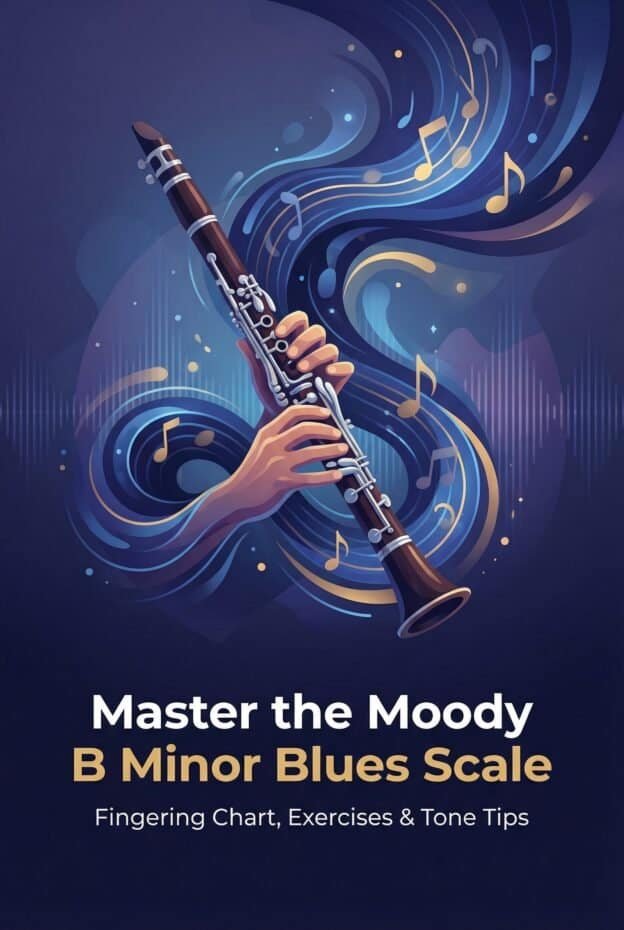The B Minor Blues Scale on clarinet: B – D – E – F (blue note) – G – A. On B-flat clarinet, these sound as A – C – D – E-flat – E – G. Use the chalumeau register for a dark, earthy sound and the clarion register for brighter solos. A detailed fingering chart shows standard and alternate fingerings, plus practice patterns for jazz phrasing.
Free Clarinet Fingering Chart: B Minor Blues Scale
The B Minor Blues Scale for clarinet uses the notes B, D, E, F, G, and A. On B-flat clarinet these sound as A, C, D, E-flat, E, and G. The core fingerings stay simple, but the blue note F and register shifts need careful choices for good tone and intonation.
This guide provides a full written fingering chart for B minor blues in both chalumeau and clarion registers. You will see standard fingerings, useful alternates, and register-aware suggestions for smooth lines. Use it as a daily reference while you practice patterns, licks, and improvisation in B minor blues.
Below is a text-based fingering chart for the B Minor Blues Scale, written for B-flat clarinet, starting on low B in chalumeau and continuing into clarion. All fingerings assume standard Boehm-system clarinet.
Chalumeau register fingerings (written pitches)
Low B (below staff): Left hand: thumb on register tube (without pressing key), 1-2-3; Right hand: 1-2-3; low E/B key with right-hand pinky.
D (below staff): Left hand: thumb, 1-2-3; Right hand: 1-2; right-hand F/C key with pinky.
E (bottom line): Left hand: thumb, 1-2-3; Right hand: 1.
F (blue note): Standard chalumeau F: Left hand: thumb, 1-2-3; Right hand: 1-2. Alternate: add right-hand 3 for a slightly flatter, darker F if needed.
G: Left hand: thumb, 1-2-3; Right hand: open.
A: Left hand: thumb, 1-2; Right hand: open. For a darker jazz color, some players slightly shade the A key or use a more covered embouchure.
Clarion register fingerings (written pitches)
Middle B (just above staff): Register key + Left hand: thumb, 1-2; Right hand: 1-2-3. This is the clarion B that pairs well with low B in call-and-response phrases.
Clarion D (above staff): Register key + Left hand: thumb, 1-2; Right hand: 1-2.
Clarion E: Register key + Left hand: thumb, 1-2; Right hand: 1.
Clarion F (blue note): Standard: Register key + Left hand: thumb, 1-2; Right hand: 1-2. Alternate: add right-hand 3 or left-hand 3 to pull pitch down and darken the color when needed.
Clarion G: Register key + Left hand: thumb, 1-2-3; Right hand: open.
Clarion A: Register key + Left hand: thumb, 1-2; Right hand: open. Use this for brighter, projecting blues lines over a band or combo.
B Minor Blues Scale – Notes, Intervals, and Musical Role
The B Minor Blues Scale is built from the notes B, D, E, F, G, and A. In interval terms, that is 1, flat 3, 4, flat 5, 5, and flat 7 of B. On B-flat clarinet, these sound a whole step lower, but you read and finger them exactly as written.
This scale combines the natural minor sound with a strong blues color from the flat 3 and flat 5. The F acts as the blue note, creating tension that resolves to E or G. In jazz and blues, clarinetists use this scale over B minor, B7, and B7#9 chords, and over E minor in many tunes.
Because of its shape, the B Minor Blues Scale fits well under the fingers in both chalumeau and clarion registers. It lets you move quickly between dark, woody low notes and bright, vocal high notes. This contrast is one reason clarinet solos in B minor blues can sound especially expressive.
How to Read This Fingering Chart (Register and Notation Notes)
Clarinet is a transposing instrument, so when you read a written B, the sounding pitch is A. For practicing the B Minor Blues Scale, you can ignore the concert pitch at first and focus on written notes and consistent fingerings. Band directors can later relate written B minor blues to concert A minor blues.
The chart in this guide uses standard notation names for written clarinet pitches. “Chalumeau” refers to the low register, from low E up to about written B-flat. “Clarion” covers the middle register, from written B to about high C. The register key on the back of the clarinet moves most notes up by a twelfth, not just an octave.
When you see the blue note F listed, remember that its pitch can be flexible for expression. Slightly bending the pitch with embouchure or alternate fingerings is stylistically correct in blues. Use the chart to learn the stable fingerings first, then experiment with color and intonation once your basic control is solid.
Downloadable Fingering Chart and Visuals (PDF/Printable)
This article is supported by a printable B Minor Blues Scale fingering chart in PDF format. The chart shows chalumeau and clarion fingerings on staff notation, plus simple clarinet diagrams for each note. Each diagram highlights the tone holes and keys used, including alternate options for the blue note F.
The PDF includes three views: a basic scale up and down, a two-octave version, and common blues licks built directly from the B Minor Blues Scale. Teachers can print copies for sectionals or studio lessons, and students can keep a copy in their practice binder or on a stand for quick reference.
Visual learners often find that fingering diagrams speed up memorization of the scale pattern. Once you can see which fingers stay down across several notes, the pattern feels more like a shape than a list of notes. That shape is what you will rely on when improvising at faster tempos.
Practice Routines: Warmups, Patterns, and Improvisation Exercises
To master the B Minor Blues Scale on clarinet, combine slow tone work, technical patterns, and short improvisation drills. Start in the chalumeau register, then add clarion. Use a metronome and track your tempos so you can measure progress from week to week.
Slow warmups for tone and intonation
Begin with long tones on each scale degree: B, D, E, F, G, A, then back down. Hold each note for 8 counts at quarter note = 60, using a tuner. Aim to keep the blue note F within about +/-10 cents of your target. Adjust embouchure, air, and alternate fingerings as needed.
Repeat the same exercise in clarion register. Focus on smooth register changes between low F and clarion F, and between low A and clarion A. Keep your throat open and your tongue relaxed so the sound stays warm and centered, not pinched or nasal.
Technical patterns for speed and control
Next, play the B Minor Blues Scale in eighth notes, two octaves if possible. Start at quarter note = 60 and increase by 4 bpm when you can play cleanly three times in a row. Use patterns such as 1-2-3-4, 2-3-4-5, 3-4-5-6, and back down, or triplet patterns like B-D-E, D-E-F, E-F-G, and so on.
Practice the scale in thirds: B-D-F, D-F-A, E-G-B, and similar variations. These patterns appear often in jazz solos and help you hear the blues color inside more complex lines. Alternate between chalumeau-only patterns and mixed-register patterns that cross the break.
Improvisation exercises and call-and-response
Once the scale feels comfortable, improvise 2-bar phrases using only B, D, E, F, G, and A. Limit yourself to chalumeau first, then clarion, then both. Record yourself and listen for clear rhythm, strong tone, and convincing use of the blue note F resolving to E or G.
Try call-and-response: play a short idea in chalumeau, then answer it in clarion with the same rhythm but different notes from the scale. This builds register awareness and helps you connect the fingerings into musical sentences, not just exercises.
Rhythm, Swing Feel, and Stylistic Uses in Jazz & Blues
The B Minor Blues Scale is only powerful if your rhythm and feel are convincing. On clarinet, articulation and air shape the swing feel as much as the fingerings. Practice the scale using swung eighth notes, accenting the offbeats slightly and keeping your air steady through the line.
Use light, forward tonguing on most notes, with occasional slurs to connect expressive phrases. Many jazz clarinetists favor a slightly softer reed and a flexible embouchure so they can shape attacks and releases. Experiment with ghosted notes, where you play very lightly on certain scale tones to create contrast.
Stylistically, the B Minor Blues Scale works over minor blues forms, modal vamps, and many jazz standards that use B minor or B7 harmony. Combine it with arpeggios of Bm7, E7, and F#7 to outline the chord changes more clearly. The blue note F often leans into E over E7 chords, creating a strong blues flavor.
Famous Clarinetists and Historical Context (Benny Goodman, Buddy DeFranco, archives)
The blues scale grew out of African American musical traditions in the late 19th and early 20th centuries. Field hollers, spirituals, and early folk blues used flexible pitches between major and minor. These sounds carried into early jazz and swing, where clarinet took on a leading melodic role in many bands.
Benny Goodman often used blues-inflected lines in keys like B minor and C minor, especially in small group recordings. Buddy DeFranco brought bebop language to the clarinet, blending chromaticism with clear blues scale references. Library of Congress blues archives document early recordings where clarinet doubles or answers blues singers using similar scale shapes.
Over time, clarinetists in swing, bebop, and modern jazz have treated the minor blues scale as a basic vocabulary item. Listening to recordings by Benny Goodman, Buddy DeFranco, and later players shows how the same six-note scale can sound very different depending on rhythm, articulation, and register choices.
Troubleshooting Common Fingering, Intonation, and Register Shifts
Common problems with the B Minor Blues Scale on clarinet include unstable low B, sharp or flat blue note F, squeaks when crossing the break, and uneven tone between chalumeau and clarion. A simple troubleshooting process can help you identify whether the cause is fingering, embouchure, or instrument setup.
Unstable or weak low B
If low B drops out or cracks, first check that all tone holes are fully covered, especially right-hand 3 and the low E/B pinky key. Firm up your air support and keep your throat open. If the note still feels unreliable, inspect the pads on the right-hand stack and low joint for leaks that a technician should repair.
Out-of-tune blue note F
When F sounds sharp, try adding right-hand 3 or left-hand 3 as an alternate fingering to lower the pitch slightly. Relax your embouchure and direct the air slightly lower into the mouthpiece. If F sounds flat, remove extra fingers, firm the corners of your embouchure, and check that your reed is not too soft or waterlogged.
Squeaks and rough register shifts
Squeaks between E and clarion B or F usually mean the register key is not coordinated with your fingers. Practice slow slurs across the break, focusing on moving the left-hand 1 finger and register key together. Keep your tongue low and relaxed so the voicing does not jump unpredictably.
If squeaks persist even with careful technique, inspect the register key pad and mechanism for leaks or sluggish movement. A small leak at the register vent can cause unstable clarion notes, especially in blues lines that lean on clarion F and G.
Clarinet Anatomy & Setup Tips That Affect Blues Tone
Several parts of the clarinet directly affect how the B Minor Blues Scale responds and sounds. Understanding basic instrument anatomy helps you choose fingerings and setup that support a warm, flexible blues tone across both registers.
The mouthpiece and reed form the vibration source. A medium-facing mouthpiece with a reed that is not too hard lets you shape the blue note F and bend pitches slightly without losing control. The ligature holds the reed evenly, which helps stabilize low B and soft entrances on D and E.
The barrel and upper joint contain the register key and throat tone holes. Small changes in barrel length affect overall pitch; pulling out slightly can help keep clarion F from running sharp. The register key vent and throat tone holes influence how easily you cross from chalumeau E and F to clarion B and C, which is important for mixed-register blues lines.
The lower joint and bell support the resonance of low notes like B and D. Well-seated pads and clean tone holes here make the bottom of the B Minor Blues Scale speak clearly. When these notes respond easily, you can play more nuanced dynamics and inflections typical of blues phrasing.
Maintenance Tips for Better Tone and Consistent Fingerings
Good maintenance improves tone, intonation, and fingering reliability for the B Minor Blues Scale. Start with reed care: rotate at least 3 to 4 reeds, break them in gradually, and store them flat in a ventilated case. Replace reeds that feel too soft or warped, since they make the blue note F unstable.
Clean the mouthpiece daily with a swab or soft brush and lukewarm water, avoiding hot water that can warp it. Swab the clarinet body after each session to remove moisture that can swell pads or clog tone holes. Pay special attention to the tone holes around E, F, and G, since buildup there affects intonation and response.
Check pads and corks regularly. If you notice persistent leaks on low B or inconsistent clarion response, schedule a visit with a qualified technician. Seasonal changes in humidity can shift key heights and pad seating, so a yearly checkup helps keep your blues playing reliable throughout the year.
Player Outcomes: What Youll Master by Learning This Scale
With focused practice on the B Minor Blues Scale, you can set clear, measurable goals. Aim to play the scale cleanly in two octaves at quarter note = 100 in swung eighth notes, with even tone in both chalumeau and clarion. Track your tempo and accuracy over several weeks to see progress.
Use a tuner to keep the blue note F within about +/-10 cents of your target pitch in both registers. Work on smooth transitions between low F and clarion F in 8-bar phrases, so register shifts sound intentional, not accidental. Record short solos and listen for consistent intonation and confident use of the scale.
As you improve, create 16-bar blues choruses using only the B Minor Blues Scale and simple chord tones. This limitation forces you to focus on rhythm, articulation, and register contrast. Over time, you will hear how a small set of notes can support expressive, personal improvisation on clarinet.
References, Further Reading, and Frequently Asked Questions
To deepen your understanding of the B Minor Blues Scale and its clarinet applications, study transcriptions of solos by Benny Goodman and Buddy DeFranco that feature minor blues material. Explore Library of Congress blues recordings to hear early uses of blue notes and flexible pitch in vocal and instrumental music.
Method books on jazz clarinet, blues improvisation, and scale studies can provide additional patterns and etudes in B minor. Combine those resources with the fingering chart and exercises in this guide to build a personal practice routine that fits your level and goals.
Key Takeaways
- The B Minor Blues Scale on clarinet uses B, D, E, F, G, and A, with F as the expressive blue note.
- Accurate fingerings and alternate options for F help control intonation across chalumeau and clarion registers.
- Regular maintenance, thoughtful setup, and structured practice routines directly improve blues tone and improvisational fluency.
Frequently Asked Questions
What is B Minor Blues Scale?
The B Minor Blues Scale is a six-note scale built from B, D, E, F, G, and A. In interval terms, it uses the root, flat 3, 4, flat 5, 5, and flat 7 of B. Clarinetists use it to create blues and jazz lines over B minor and B7-based harmonies.
How do I finger the B Minor Blues Scale on clarinet across registers?
In chalumeau, use standard low fingerings from B up to A: low B with full fingers and low E/B key, then D, E, F, G, and A. In clarion, add the register key for B, D, E, F, G, and A above the staff. Learn both sets, then practice patterns that cross between them for smooth register shifts.
Why does the F (the blue note) sound out of tune and how can I fix it?
The blue note F often runs sharp or flat because it sits in a sensitive part of the clarinet scale. Use alternate fingerings, such as adding right-hand 3, to lower sharp F, and adjust your embouchure and air direction. A tuner and slow long tones help you stabilize its pitch within about +/-10 cents.
Can I use the B Minor Blues Scale for jazz standards and improvisation?
Yes. The B Minor Blues Scale works over Bm7, B7, and related chords in many jazz standards and blues progressions. Combine it with chord tones and arpeggios to outline changes more clearly. Start by improvising over simple B minor or B7 vamps, then apply it to full 12-bar blues forms.
Where can I download a printable B Minor Blues fingering chart?
A printable B Minor Blues Scale fingering chart is available as a PDF that includes chalumeau and clarion fingerings, alternate options for the blue note F, and sample patterns. Teachers and students can print it for daily practice and use it as a quick reference during rehearsals and lessons.
What maintenance steps improve blues tone on a clarinet?
Rotate and properly break in reeds, clean the mouthpiece and bore regularly, and swab the instrument after each session. Check pads and corks for leaks that affect low B and clarion response. A well-maintained clarinet offers more stable intonation, easier response, and a warmer, more flexible tone for blues playing.







